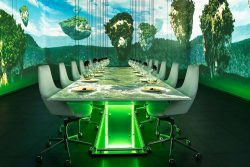|
|
Brett Camilleri graduated from QUT with a MPhil (Service Design) before joining 3rdView. Inspired by 3rdView office banter he considers…
“How do classic design styles correspond with modern services?”
As a design nerd, I found myself in a conversation with the other 3rdViewers about service design and its history. Whilst service design has matured as a discipline in the 21st century, it’s still quite new; if architecture is the grandfather of the design discipline, Service design is still ‘in utero’. When I think about the discipline, I realise that we’ve only just begun to write the history of service design. This revelation becomes more interesting if we consider each period’s morals and they influenced the mediums produced. Since we missed rococo by about 200 years, I figured that it was my duty as an amateur design historian to muse how these classic design styles corresponded to the modern services that we know, and how they might change if they were designed in a different period.
“be it the renaissance’s rejection of divinity in favour of logic and order, or the arts and craft’s celebration of imperfection and humanity; it’s the milieu of these times that inspired the forms we think of today”
But service experiences don’t really have a face, so how applicable are these historical aesthetics their conception? Well to that I say that these styles were not created in a vacuum. The artefacts produced by our predecessors were the physical manifestation of philosophies, perspectives and principles of their time, be it the renaissance’s rejection of divinity in favour of logic and order, or the arts and craft’s celebration of imperfection and humanity; it’s the milieu of these times that inspired the forms we think of today. Therefore, I will use these values as the link between past styles and modern services.
As a quick aside, my undergraduate history classes predominantly covered western architecture and industrial design so unfortunately this list will be biased towards these styles. I’m a design nerd however, so I’d love to learn some additional history from the comments and how it applies to the services mentioned below! So with that said, what’s on the wall? For this thought experiment, I’ve decided to focus on services which help us organise and eat food. Partly because food formed a strong point of focus for my research, partly because it’s something that everyone does and can relate to (which also means there’s many different services available!). All of which make it much easier for me to draw some comparisons at the end. So with the introductions completed, lets dig in!
Classical and Romanesque

“Despite their seemingly basic function, classical services are born from the deep consideration of customer problems which are addressed in a straightforward manner”
After translating these features in my head, how would I characterise a classical service? Despite their seemingly basic function, classical services are born from the deep consideration of customer problems which are addressed in a straightforward manner. Furthermore, their continued resolution of these problems mean that some classical services are quite established, having facilitated their purpose unchanged for a very long period of time. These attributes considered, a ‘classical’ food service that instantly comes to mind would be a grocer. Its purpose within the customer’s life is to form a bridge between them and produce is relatively simple yet highly necessary. And despite increases in scale, technology, product variation, and logistical complexity, the customers perspective of the grocer’s role has remained relatively unchanged for 100’s of years.
Gothic
Emerging as the archetypal model for Christian churches, Gothic architecture is characterised by tall vaulted ceilings and large iconic windows which stretch towards the heavens. For those who visit, these features incite awe as height and light are used to remind them of their sense of scale and place in contrast to a higher natural order. Through its predominant use by the church, Gothic architecture emerged as a central point for community, hierarchy and faith in feudal towns experiencing rapid growth. So when presented with these attributes of scale, community, hierarchy and faith, I’ve found an unexpected parallel customer experience in the exclusive Le Dîner en Blanc event; hear me out.
“What could be perceived as a restrictive and domineering experience, the gothic services instead create a sense of community through its transcription of process”
Hosted annually all around the world, this invite-only ‘chic picnic’ is where you grab your finest white garments and dining accoutrement, the folding square table, and go to a designated pickup area where you will be ferried to a mysterious location. Upon arrival, patrols are instructed where to set up, when to eat, when to dance and when to disperse. Finally, whether rain or shine, attendance is mandatory (they will allow white or transparent umbrella’s and overcoats however). So how does this experience compare to the gothic themes I presented before? The Le Dîner en Blanc experience has a strong community aspect (1000’s of diners all dressed in white), an established hierarchy (strict clothing, food and equipment rules) and strong faith from its patrons (mystery location and mandatory attendance). But despite patrons surrendering to the strict instruction of Le Dîner en Blanc, their enactment of this dining ritual unites an almost unaffiliated community through a unique experience. What could be perceived as a restrictive and domineering experience, the gothic services instead create a sense of community through its transcription of process.
Rococo
Emerging from a change in artistic direction, The Rococo style emerged from French artists with a strong interest in asymmetry, nature and detail. As this style translated to architecture, it resulted in interiors and furniture that were decadent, highly ornamental and lavishly decorated. Consequently, this high attention to detail and craftsmanship ensured that Rococo style could also only be afforded by the ruling elite at the time, where it was found in palaces and the newly invented parlour room. Transferring these characteristics to an experience, I have determined the characteristics of a Rococo service as lavish, exclusive, decadent and striking. So what food service have I identified as representative of a Rococo experience? Why a number of restaurants and bars situated within Dubai’s!
“Rococo services use extravagance and superfluous moments to impart sensations of prestige and opulence to an often-exclusive user group”

Modernism
Let’s say this together! Form follows function. Now that we’ve got that out of our system, let’s look at where this design psalm originated from. During the first half of the 20th century, a number of very serious architects and industrial designers saw the devastation from the first world war and decided that an analytical and scientific approach was essential to the creation of products and architecture fit for a Utopia. From this perspective, Modernists endeavoured to use the purpose of an artefact to inform what form and material traits were appropriate. This infatuation with functionality informed a design movement which emphasised the strategic application of modern industrial materials and techniques, and held a severe distaste for superfluous ornamentation. This resulted in products and an architecture which were minimal in its aesthetic, rejecting the flowing and decorative styles of their pre-war creatives. But in striving for an aesthetic focused on technology, function and material, Modernist design was also considered to be quite impersonal and inhuman.
“A modernist service’s strict focus on adopting functional elements of a user’s activity ensures that their personal goals are much more easily achieved”

Post-modernism
While the modernists rebelled against the decorative preferences of their predecessors, another group of designers got sick of the black turtlenecks and glasses (but not really, we’re designers after all). As time passed, these designers began to question just how appropriate modernist design was; a primary concern being that we’d forgotten what feelings and fun were. Instead, these designers threw form follows function to the wind and in its stead, form follows emotion was adopted. Post-modern designers scream that surprise, novelty and amusement are just as important to the human experience as being able to use the thing. Their reasoning being that if the pursuit of pure functionality comes at the cost of an impersonal and bland experience, a perfectly functional design is moot if the user never wants to use it again. Thus, in sheer rejection of their contemporaries’ modernist ideals, Post modernism uses comparison critique and surprise to cheekily create something unexpected for the user to experience.
“Patrons of a post-modern service are likely to excitedly describe the sequence of events just as much as (if not more than) what was eaten that night”
So what could be defined as a post-modern service experience? While I could have selected pretty much anything done by Heston Bloomingthal, I’ve chosen Sublimotion. Sublimotion captures a post-modernist service perfectly by its creation of a themed event which expands beyond the consumption of a meal. Upon arriving, Virtual reality, augmented reality, edible props and spectacle are used to a visceral sensation of delight and surprise within the user, where the act of nourishment takes a back seat to the creation of emotion. Thus, much to the scoff of 1950’s modernists, patrons of a post-modern service are likely to excitedly describe the sequence of events just as much as (if not more than) what was eaten that night.
So What?
So as a service designer, are you wondering “what do I do with this information?”. What started out as a fun but fruitless thought experiment, this exercise has inspired a number of useful takeaways. First being how these design styles can act as a short form to characterise the values which drastically influenced the function of a service. At a glance, each style characterises the customer experience as:
- Classical: a founding Experience, being the first in a space, this is how customers expect X to function
- Gothic: the user’s experience places faith in the service to guide their experience, and is a part of a larger community
- Rococo: The user wants to be the centre of the universe
- Modernism: the user simply wants a task to be done
- Post Modernism: the user wants to be amused and tantalised.
In recognising these values, it makes it possible to distinguish services that at face value may share the same attributes, but provide an entirely different experience to the user. For instance, Sublimotion’s whopping $2500 price for a seat at that table easily falls within the exclusive experiences found within Dubai’s luxury hotels. Furthermore, each experience isn’t derived solely from the food, but the spectacle that accompanies them. But post-modern experiences differ in the type of experience created, where the user’s sense of surprise and amusement are used to create joy.
“Outside of this surface level means of evaluating the experience of existing services, these service styles could also be a fun shift in perspective to inspire alternative experiences for existing services”
However, the experience offered by Sublimotion’s differs from that of Gold on 27 by appealing to the customer’s visceral sense of surprise and amusement rather than status, excess and social standing. Outside of this surface level means of evaluating the experience of existing services, these service styles could also be a fun shift in perspective to inspire alternative experiences for existing services. For instance, if you’re founded a “classical” service experience and you’ve got quite a few competitors, it might be time to consider another experience or risk antiquation. Rather than developing an app that does more of the same (i.e. engaging in some Neo-classicalism), maybe it’s time to dabble in a gothic experience by developing a central community, or creating some spontaneous, if not superfluous fun through post-modern service.
So that’s my casual exploration into design history, the values behind them, and my fun Buzzfeed’esque comparison to service design styles. What I’m about curious however is what we can learn from contemporary design trends. Sustainability (both environment and social) have proven to be prominent new areas. Only this time we can help – if we have industrial designers creating biodegradable furniture, what form will it take through sustainable service design? As UX researchers examine privacy and individual rights, what form does the service take on?







